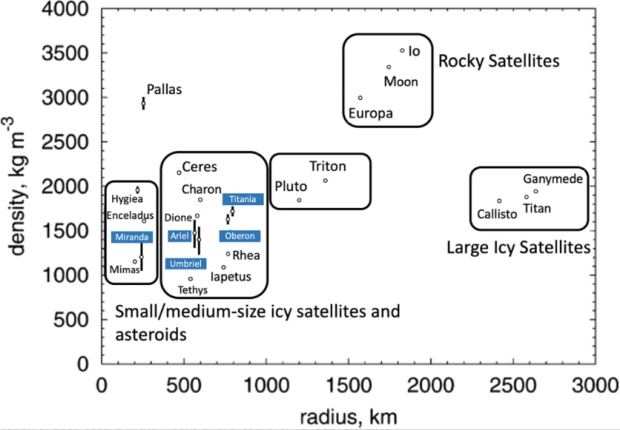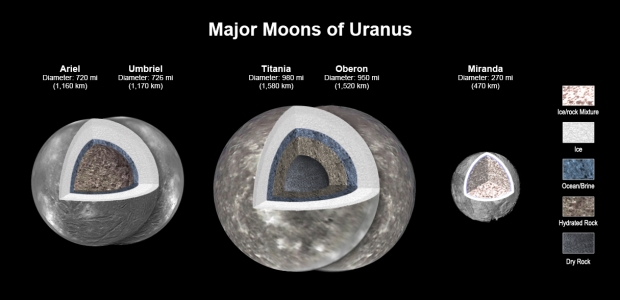Further fueling my interest in reaching the ice giants is a study in the Journal of Geophysical Research: Planets that investigates the possibility of oceans on the major moons of Uranus. Imaged by Voyager 2, Uranus is otherwise unvisited by our spacecraft, but Miranda, Ariel, Titania, Oberon and Umbriel hold considerable interest given what we are learning about oceans beneath the surface of icy moons. Hence the need to examine the Voyager 2 data in light of updated computer modeling.
Julie Castillo-Rogez (JPL) is lead author of the paper:
“When it comes to small bodies – dwarf planets and moons – planetary scientists previously have found evidence of oceans in several unlikely places, including the dwarf planets Ceres and Pluto, and Saturn’s moon Mimas. So there are mechanisms at play that we don’t fully understand. This paper investigates what those could be and how they are relevant to the many bodies in the solar system that could be rich in water but have limited internal heat.”

Image: This is Figure 1 from the paper. Caption: Densities and mean radii of the Uranian moons compared to those of other large moons and dwarf planets. Miranda has a low density similar to Saturn’s moon Mimas, whereas the densities of the other Uranian moons are more similar to Saturn’s moons Dione and Rhea. After Hussmann et al. (2006).
The interest is more than theoretical, for as we’ve recently discussed the Planetary Science and Astrobiology Decadal Survey for 2023–2032 has put a Uranus Orbiter and Probe mission on its short list of priorities. A mission to Uranus would open up the prospect for confirming oceans, or the lack of same, within the five large moons. Recent work explored in the Castillo-Rogez paper has made the case that magnetic fields induced by such oceans should be detectable by a Uranus orbiter’s flybys.
Much has happened to call for new modeling of this system. The paper notes recent advances in surface chemistry and geology, revised models of system dynamics, and the knowledge gained on icy bodies in the size range of the Uranian moons as studies have continued on Enceladus and the moons of Saturn as well as Pluto and Charon, not to mention the availability of data from the Dawn mission at Ceres. The team’s modeling produces likely interior structures that are promising for four of the moons.
These moons are indeed small objects, and while Uranus has 27 moons, it is only when we reach the size of Ariel (1160 kilometers) that we can start talking realistically about interior oceans. Titania is the largest of these at 1580 kilometers. The paper argues that of the five largest moons, we can exclude Miranda (470 kilometers) as being too small to sustain the heat to support an internal ocean. But the other four appear promising, revising and contradicting earlier work that had focused primarily on Titania and Oberon in the belief that Ariel, Umbriel, and Miranda would be frozen at present.

Image: New modeling shows that there likely is an ocean layer in four of Uranus’ major moons: Ariel, Umbriel, Titania, and Oberon. Salty – or briny – oceans lie under the ice and atop layers of water-rich rock and dry rock. Miranda is too small to retain enough heat for an ocean layer. Credit: NASA/JPL-Caltech.
Of the large Uranian moons, Ariel may emerge as the best possibility. From the paper:
Ariel is particularly interesting as a future mission target because of the potential detection of NH3-bearing species on its surface (Cartwright et al., 2021) that could be evidence of recent cryovolcanic activity, considering these species should degrade on a geologically short timescale. Geologic features, visible in Voyager 2 Imaging Science Subsystem images of Ariel, show some evidence for cryovolcanism in the form of double ridges and lobate features that may represent emplaced cryolava (Beddingfield & Cartwright, 2021).
But oceans tens of kilometers deep at Titania and Oberon may yet excite astrobiological interest, depending on what we learn about heat sources here.
Based on current understanding, we conclude that the Uranian moons are more likely to host residual or “relict” oceans than thick oceans. As such, they may be representative of many icy bodies, including Ceres, Callisto, Pluto, and Charon (De Sanctis et al., 2020). The detection and characterization (depth and thickness) of deep oceans inside the Uranian moons… and refined constraint on surface ages would help assess whether these bodies still hold residual heat from a recent resonance crossing event and/or are undergoing tidal heating due to dynamical circumstances that are currently unknown (as was the case at Enceladus before the Cassini mission).
The Uranus Orbiter and Probe mission holds great allure for answering some of these questions. The issue of detection by a spacecraft is still charged, however. The authors note from the outset that an ocean maintained primarily by ammonia would be well below the water freezing point, in which case its electrical conductivity might be too low to register on the UOP’s sensors. In other words, ammonia essentially acts as an antifreeze, with electrical conductivity near zero. Temperatures below ~245 K would mean an ocean would have to be detected by the exposure of deep ocean material, in which case we come back to Ariel as the most likely target for the closest scrutiny.
The paper is Castillo-Rogez et al., “Compositions and Interior Structures of the Large Moons of Uranus and Implications for Future Spacecraft Observations,” JGR Planets Vol. 128, Issue 1 (January 2023). Abstract.



Hi Paul
Yes this is interesting stuff indeed, we really need missions to both of the ice giants of our solar system.
The Paper was interesting reading as well
Thanks Edwin
Perhaps one day we will cut through the ice layers to the oceans beneath, maybe a largish ring that is heated and slowly melts its way to the ocean below, perhaps adding salt to the ring melt direction will prevent refreezing could allow us to get there better.
I think it more likely that we will explore moons like Enceladus and Europa first. The further out we go the more it costs in time and money. The moons of Uranus sound fascinating but resources are and will remain limited.
An Old Planetary Romance (“The Interplanetary Adventurers”) featured primitive tribes on Titania. All the discussion of sub-glacial Oceans on the moons of Uranus makes me think wistfully of how such a thing might work. While the depth sounds formidable, there’s plenty of evidence of advection. Perhaps warm ice plumes have created networks of hollows beneath the surface.
All these decades of speculation are just an infuriating reflection of the failure to send hardware. We haven’t even sent explorers on the level that was within our grasp at the time, let alone what is or will soon be possible. It should make the curious and visionary alike angry. Just petty little politics down here determine decades of what stays in shadow. It’s not right.
Europe’s JUICE Jupiter probe fixes antenna glitch in deep space (video)
https://www.space.com/juice-jupiter-probe-fixes-antenna-glitch
“The Crystal Ship, Is Sailing Now…” Pykecrete 2.0
Curious now- given that we seem to have warm oceans out beyond 15 AU, I’m trying to figure out how much energy could be extracted by transferring heat from the warm moon interiors out into space.
If this included the extraction of warm water at the surface or even directed ‘geysering’ for expansive cooling, it occurred to me that there would be an opportunity for H²O to become a structural component for surface and orbital facility fabrication.
If we have hydrogen, carbon and nitrogen then we have CH²=CHCNH². AKA acrylamide, AKA Kevlar.
So perhaps our composites in the outer solar system will be locally made ‘reinforced concrete’ composed of water ice + Kevlar = Pykecrete 2.0 mixtures that are strong, light, and readily available.
Spacecoach: Toward a Deep Space Infrastructure
Get a ball of hemp string and put it in a plastic cup full of water and then freeze it. Once frozen try destroying it with a hammer, not so easy !